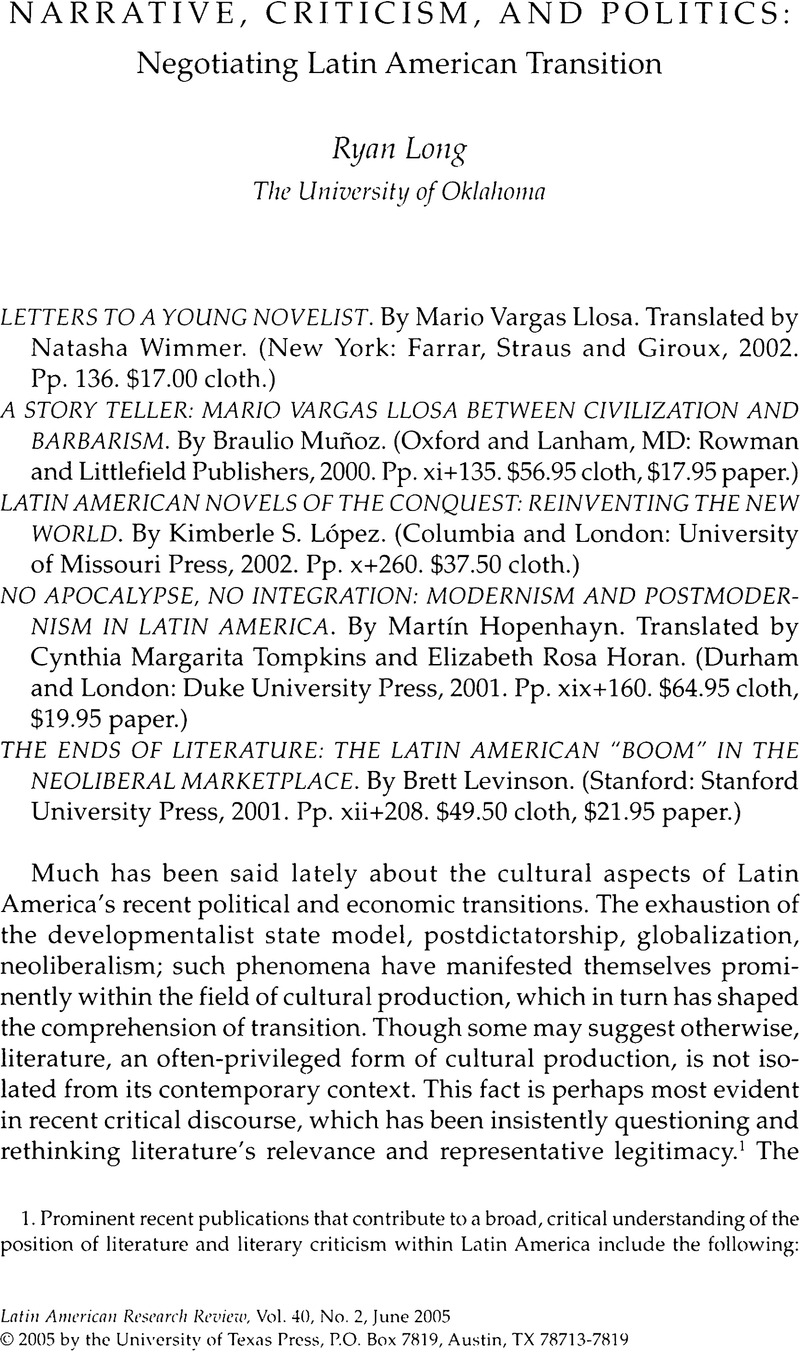No CrossRef data available.
Article contents
Narrative, Criticism, and Politics: Negotiating Latin American Transition
Review products
Published online by Cambridge University Press: 05 October 2022
Abstract

- Type
- Review Essays
- Information
- Copyright
- Copyright © 2005 by the University of Texas Press
References
1. Prominent recent publications that contribute to a broad, critical understanding of the position of literature and literary criticism within Latin America include the following: Idelber Avelar, The Untimely Present: Postdictatorial Latin American Fiction and the Task of Mourning (Durham and London: Duke University Press, 1999); John Beverley, Subalternity and Representation: Arguments in Cultural Theory (Durham and London: Duke University Press, 1999); Jean Franco, The Decline and Fall of the Lettered City (Cambridge and London: Harvard University Press, 2002); Francine Masiello, The Art of Transition: Lathi American Culture and Neoliberal Crisis (Durham and London: Duke University Press, 2001); Alberto Moreiras, The Exhaustion of Difference: The Politics of Latin American Cultural Studies (Durham and London: Duke University Press, 2001); and Alberto Moreiras, Tercer espacio: Literatura y duelo en América Latina (Santiago: Universidad Arcis/LOM ediciones, 1999).
2. The Boom formed part of a broader philosophical trend, namely the quest for Latin American identity, whose validity was bolstered by the works of, among others, Samuel Ramos, Fernando Ortiz, Octavio Paz, and Leopoldo Zea, not to mention the Boom's immediate predecessors and early cofounders, like Miguel Angel Asturias and Alejo Carpentier. My emphasis on these last two writers owes itself to a work that provides a particularly insightful general perspective on the Boom's literary context, Gerald Martin's Journeys through the Labyrinth: Latin American Fiction in the Twentieth Century (London: Verso, 1989).
3. Two particularly influential and optimistic contemporary definitions of the Boom were written, not surprisingly, by Boom novelists: Carlos Fuentes, La nueva novela hispanoamericana (México, DF: Joaquín Mortiz, 1969); and Mario Vargas Llosa, García Márquez: Historia de un deicidio (Barcelona and Caracas: Seix Barrai, 1971). A clear enunciation of the Boom's political ramifications, in relation to the Cuban Revolution's importance as a model for emancipation, is Jaime Mejía Duque's Narrativa y neocoloniaje en América Latina (Buenos Aires: Editorial Crisis, 1974). An important early criticism of the Boom is Angel Rama's “El ‘boom’ en perspectiva,” in Más allá del boom: Literatura y mercado, edited by David Viñas, et al., 51–110 (México, DF: Marcha Editores, 1981).
4. Op. cit.
5. Mario Vargas Llosa, Cartas a un joven novelista (Barcelona: Ariel/Planeta, 1997).
6. Levinson rejects the desire for totality that Vargas Llosa expresses. See below. Two significant contributions to comprehending a literary work's representative limitations and what they reveal about the context of its production are Frederic Jameson's The Political Unconscious: Narrative as a Socially Symbolic Act (Ithaca: Cornell University Press, 1981); and Pierre Macherey's A Theory of Literary Production, trans. Geoffrey Wall (London and New York: Routledge, 1978).
7. Levinson develops a similar argument, but from a very different perspective (30). He does not share Muñoz's optimism regarding modernity's continuing influence as a counterweight to the market's hegemony. See below.
8. Muñoz often defines postmodernism parenthetically, without explaining precisely what he means, like when he contends that Lacan, Derrida, and Foucault, as “postmodern theorists,” responded positively to Lukacs's request that critics exhibit “‘virile maturity‘” (11); or when he condemns the “gaping nihilism postmodernism fosters” (29).
9. For two different, extensively developed positions on the allegedly universal western tradition's exclusive origins, see Walter Mignolo's The Darker Side of the Renaissance: Literacy, Territoriality, and Colonization (Ann Arbor: University of Michigan Press, 1995), and Gayatri Chakravorty Spivak's A Critique of Postcolonial Reason: Toward a History of the Vanishing Present (Cambridge: Harvard University Press, 1999).
10. As López acknowledges, the genre's characteristics are discussed in detail in Seymour Menton's Latin America's New Historical Novel (Austin: University of Texas Press, 1993).
11. For other recent scholarship on Latin American modernity, see Néstor García Canclini's Hybrid Cultures: Strategies for Entering and Leaving Modernity, trans. Christopher L. Chiappari and Silvia L. López (Minneapolis: University of Minnesota Press, 1995), and Through the Kaleidoscope: The Experience of Modernity in Latin America, edited by Vivian Schelling (New York: Verso, 2001).
12. Julio Cortázar, “Axolotl,” Ceremonias (Barcelona: Seix Barral, 1983) 125–30.
13. Ricardo Piglia, Respiración artificial, (Buenos Aires: Editorial Pomaire, 1980).
14. As Levinson acknowledges, his observations on writing are influenced by the work of Jacques Derrida, particularly Dissemination, trans. Barbara Johnson (University of Chicago Press, 1982).




